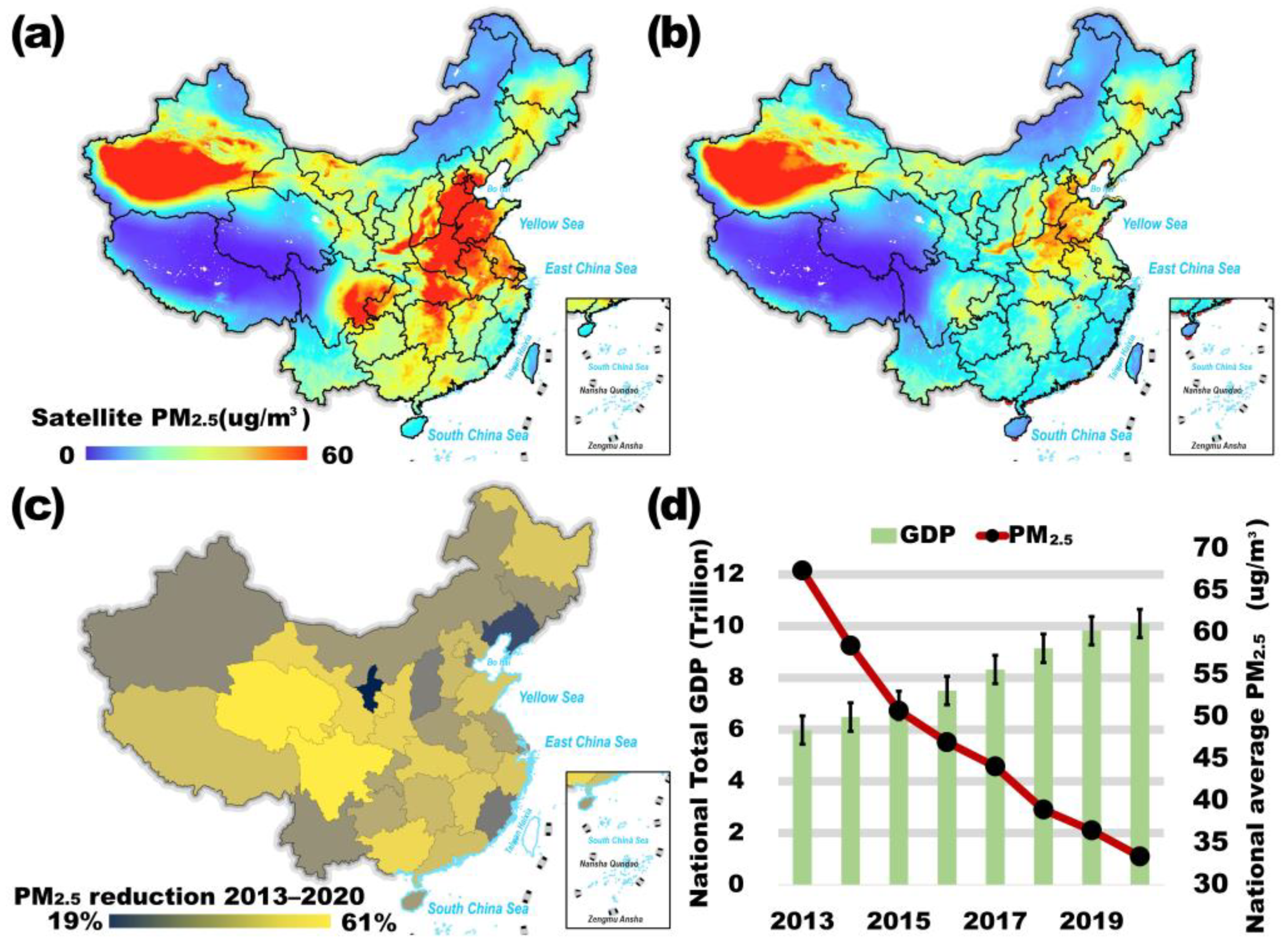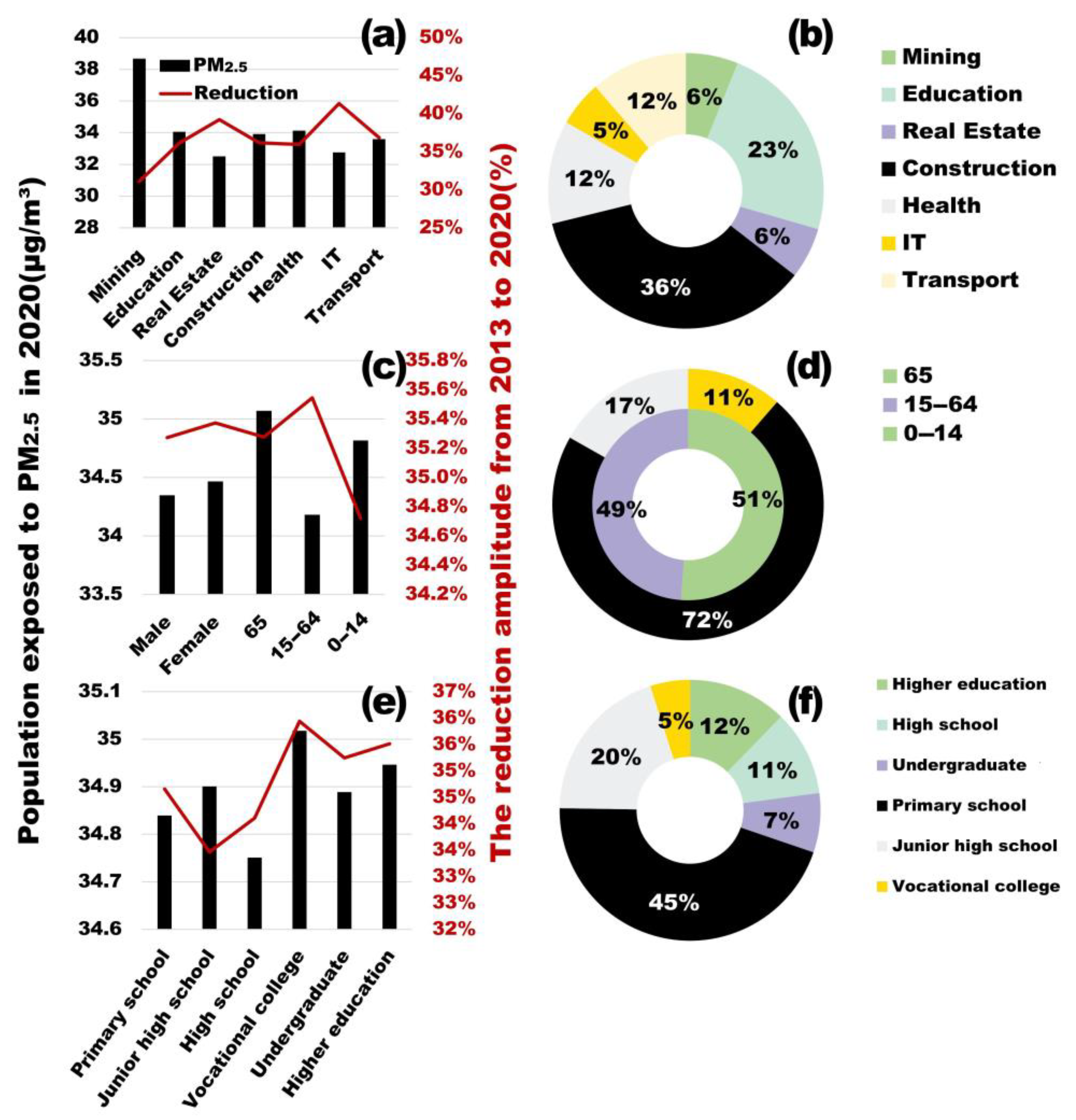Inequitable Air Quality Improvement in China: Regional and Population-Level Disparities in PM Exposure (2013–2020)
Abstract
1. Introduction
- Geographic differences: Individuals in areas with favorable natural conditions face fewer environmental injustices [13]. Additionally, within urban settings, air pollution exposure can vary significantly due to localized environmental conditions and neighborhood characteristics, revealing substantial disparities in pollution exposure even at small scales [14]. Factors such as transportation issues [15,16,17] and geographic advantages and disadvantages are primary influences on the population’s resilience to environmental challenges [18].
- Sociological impacts: The negative effects of PM2.5 pollution on the health of older adults are becoming increasingly pronounced [4,30,31,32,33,34], and women aged between 30 and 45 are exposed to twice as much pollution as the general adult population, undermining the benefits of improved air quality and healthcare advancements [35,36,37,38]. This disparity adversely affects people’s subjective well-being and mental health.
2. Materials and Methods
- represents the population-weighted average PM2.5 concentration.
- is the PM2.5 concentration of the ith raster.
- is the population of the ith raster.
- is the total number of rasters.
3. Results
3.1. Spatial and Temporal Characteristics of Economic Development and Air Pollution in China
3.2. Regional Equity Analysis of Emission Reductions
3.3. Differences in Pollution Exposure Between Urban and Rural Areas
3.4. Differences in PM2.5 Exposure Among Social Groups
4. Conclusions
Author Contributions
Funding
Institutional Review Board Statement
Informed Consent Statement
Data Availability Statement
Conflicts of Interest
References
- International Energy Agency. World Energy Outlook 2024; International Energy Agency: Paris, France, 2024. [Google Scholar]
- Hao, Y.; Chen, H.; Zhang, Q. Will income inequality affect environmental quality? Analysis based on China’s provincial panel data. Ecol. Indic. 2016, 67, 533–542. [Google Scholar] [CrossRef]
- de Leeuw, G.; van der A, R.; Bai, J.; Xue, Y.; Varotsos, C.; Li, Z.; Fan, C.; Chen, X.; Christodoulakis, I.; Ding, J. Air quality over China. Remote Sens. 2021, 13, 3542. [Google Scholar] [CrossRef]
- Fiordelisi, A.; Piscitelli, P.; Trimarco, B.; Coscioni, E.; Iaccarino, G.; Sorriento, D. The mechanisms of air pollution and particulate matter in cardiovascular diseases. Heart Fail. Rev. 2017, 22, 337–347. [Google Scholar] [CrossRef] [PubMed]
- Hamra, G.B.; Guha, N.; Cohen, A.; Laden, F.; Raaschou-Nielsen, O.; Samet, J.M.; Vineis, P.; Forastiere, F.; Saldiva, P.; Yorifuji, T. Outdoor particulate matter exposure and lung cancer: A systematic review and meta-analysis. Environ. Health Perspect. 2014, 122, 906–911. [Google Scholar] [CrossRef] [PubMed]
- Liu, C.; Chen, R.; Sera, F.; Vicedo-Cabrera, A.M.; Guo, Y.; Tong, S.; Coelho, M.S.; Saldiva, P.H.; Lavigne, E.; Matus, P. Ambient particulate air pollution and daily mortality in 652 cities. New Engl. J. Med. 2019, 381, 705–715. [Google Scholar] [CrossRef]
- Pui, D.Y.; Chen, S.-C.; Zuo, Z. PM2.5 in China: Measurements, sources, visibility and health effects, and mitigation. Particuology 2014, 13, 1–26. [Google Scholar] [CrossRef]
- He, L.; He, L.; Lin, Z.; Lu, Y.; Chen, C.; Wang, Z.; An, P.; Liu, M.; Xu, J.; Gao, S. Sensing the Environmental Inequality of PM2.5 Exposure Using Fine-Scale Measurements of Social Strata and Citizenship Identity. ISPRS Int. J. Geo-Inf. 2024, 13, 257. [Google Scholar] [CrossRef]
- Zhang, Q.; Meng, X.; Shi, S.; Kan, L.; Chen, R.; Kan, H. Overview of particulate air pollution and human health in China: Evidence, challenges, and opportunities. Innovation 2022, 3, 100312. [Google Scholar] [CrossRef] [PubMed]
- Zhang, R.; Zhu, S.; Zhang, Z.; Zhang, H.; Tian, C.; Wang, S.; Wang, P.; Zhang, H. Long-term variations of air pollutants and public exposure in China during 2000–2020. Sci. Total Environ. 2024, 930, 172606. [Google Scholar] [CrossRef] [PubMed]
- Fan, Y.; Chen, Z.; He, T.J.S. The Impact of Carbon-Emission Trading Scheme Policies on Air Quality in Chinese Cities. Sustainability 2024, 16, 10023. [Google Scholar]
- Shan, Z.; Li, H.; Pan, H.; Yuan, M.; Xu, S. Spatial equity of PM2.5 pollution exposures in high-density metropolitan areas based on remote sensing, LBS and GIS data: A case study in Wuhan, China. Int. J. Environ. Res. Public Health 2022, 19, 12671. [Google Scholar] [CrossRef]
- Quan, R. Establishing China’s environmental justice study models. Geo. Int’l Envtl. L. Rev. 2001, 14, 461. [Google Scholar]
- Kamińska, J.A.; Turek, T.; Van Poppel, M.; Peters, J.; Hofman, J.; Kazak, J.K.J.J.o.E.M. Whether cycling around the city is in fact healthy in the light of air quality–Results of black carbon. J. Environ. Manag. 2023, 337, 117694. [Google Scholar] [CrossRef]
- Golub, A.; Marcantonio, R.A.; Sanchez, T.W. Race, space, and struggles for mobility: Transportation impacts on African Americans in Oakland and the East Bay. Urban Geogr. 2013, 34, 699–728. [Google Scholar] [CrossRef]
- Moser, M.; Zwickl, K. Informal Environmental Regulation of Industrial Air Pollution: Does Neighborhood Inequality Matter? WU Vienna University of Economics and Business: Wien, Austria, 2014. [Google Scholar]
- Zheng, S.; Yao, R.; Zou, K. Provincial environmental inequality in China: Measurement, influence, and policy instrument choice. Ecol. Econ. 2022, 200, 107537. [Google Scholar] [CrossRef]
- Zheng, D.; Shi, M. Multiple environmental policies and pollution haven hypothesis: Evidence from China’s polluting industries. J. Clean. Prod. 2017, 141, 295–304. [Google Scholar] [CrossRef]
- Yang, T.; Liu, W. Does air pollution affect public health and health inequality? Empirical evidence from China. J. Clean. Prod. 2018, 203, 43–52. [Google Scholar] [CrossRef]
- Wu, H.; Guo, H.; Zhang, B.; Bu, M. Westward movement of new polluting firms in China: Pollution reduction mandates and location choice. J. Comp. Econ. 2017, 45, 119–138. [Google Scholar] [CrossRef]
- Tian, X.; Geng, Y.; Ulgiati, S. An emergy and decomposition assessment of China-Japan trade: Driving forces and environmental imbalance. J. Clean. Prod. 2017, 141, 359–369. [Google Scholar] [CrossRef]
- Zhang, W.; Liu, Y.; Feng, K.; Hubacek, K.; Wang, J.; Liu, M.; Jiang, L.; Jiang, H.; Liu, N.; Zhang, P. Revealing environmental inequality hidden in China’s inter-regional trade. Environ. Sci. Technol. 2018, 52, 7171–7181. [Google Scholar] [CrossRef] [PubMed]
- Zhao, X.; Zhang, S.; Fan, C. Environmental externality and inequality in China: Current status and future choices. Environ. Pollut. 2014, 190, 176–179. [Google Scholar] [CrossRef] [PubMed]
- He, Q.; Wang, R.; Ji, H.; Wei, G.; Wang, J.; Liu, J. Theoretical model of environmental justice and environmental inequality in China’s four major economic zones. Sustainability 2019, 11, 5923. [Google Scholar] [CrossRef]
- Ma, C. Who bears the environmental burden in China—An analysis of the distribution of industrial pollution sources? Ecol. Econ. 2010, 69, 1869–1876. [Google Scholar] [CrossRef]
- Ma, J.; Liu, B.; Mitchell, G.; Dong, G. A spatial analysis of air pollution and environmental inequality in Beijing, 2000–2010. J. Environ. Plan. Manag. 2019, 62, 2437–2458. [Google Scholar] [CrossRef]
- Ma, J.; Mitchell, G.; Dong, G.; Zhang, W. Inequality in Beijing: A spatial multilevel analysis of perceived environmental hazard and self-rated health. Ann. Am. Assoc. Geogr. 2017, 107, 109–129. [Google Scholar] [CrossRef]
- Schoolman, E.D.; Ma, C. Migration, class and environmental inequality: Exposure to pollution in China’s Jiangsu Province. Ecol. Econ. 2012, 75, 140–151. [Google Scholar] [CrossRef]
- Niu, X.-T.; Yang, Y.-C.; Wang, Y.-C. Does the economic growth improve public health? A cross-regional heterogeneous study in China. Front. Public Health 2021, 9, 704155. [Google Scholar] [CrossRef]
- Xue, T.; Zhu, T.; Zheng, Y.; Liu, J.; Li, X.; Zhang, Q. Change in the number of PM2.5-attributed deaths in China from 2000 to 2010: Comparison between estimations from census-based epidemiology and pre-established exposure-response functions. Environ. Int. 2019, 129, 430–437. [Google Scholar] [CrossRef] [PubMed]
- Tao, T.; Xin, K. Public health: A sustainable plan for China’s drinking water. Nature 2014, 511, 527–528. [Google Scholar] [CrossRef] [PubMed]
- Cao, J.; Xu, H.; Xu, Q.; Chen, B.; Kan, H. Fine particulate matter constituents and cardiopulmonary mortality in a heavily polluted Chinese city. Environ. Health Perspect. 2012, 120, 373–378. [Google Scholar] [CrossRef]
- Crouse, D.L.; Peters, P.A.; van Donkelaar, A.; Goldberg, M.S.; Villeneuve, P.J.; Brion, O.; Khan, S.; Atari, D.O.; Jerrett, M.; Pope III, C.A. Risk of nonaccidental and cardiovascular mortality in relation to long-term exposure to low concentrations of fine particulate matter: A Canadian national-level cohort study. Environ. Health Perspect. 2012, 120, 708–714. [Google Scholar] [CrossRef] [PubMed]
- Cui, Z.; Yi, X.; Huang, Y.; Li, M.; Zhang, Z.; Kuang, L.; Song, R.; Liu, J.; Pan, R.; Yi, W. Effects of socioeconomic status and regional inequality on the association between PM2.5 and its components and cardiometabolic multimorbidity: A multicenter population-based survey in eastern China. Sci. Total Environ. 2024, 946, 174453. [Google Scholar] [CrossRef]
- Chen, S.; Oliva, P.; Zhang, P. The effect of air pollution on migration: Evidence from China. J. Dev. Econ. 2022, 156, 102833. [Google Scholar] [CrossRef]
- Xu, F.; Huang, Q.; Yue, H.; Feng, X.; Xu, H.; He, C.; Yin, P.; Bryan, B.A. The challenge of population aging for mitigating deaths from PM2.5 air pollution in China. Nat. Commun. 2023, 14, 5222. [Google Scholar] [CrossRef] [PubMed]
- McKinney, L.A.; Wright, D. Gender and environmental inequality. In Handbook on Inequality and the Environment; Edward Elgar Publishing: Cheltenham, UK, 2023; pp. 228–245. [Google Scholar]
- Buckingham, S. Gender and Environment; Routledge: London, UK, 2020. [Google Scholar]
- Li, W.; Wu, M.; Niu, Z. Spatialization and Analysis of China’s GDP Based on NPP/VIIRS Data from 2013 to 2023. Appl. Sci. 2024, 14, 8599. [Google Scholar] [CrossRef]
- Zhao, N.; Liu, Y.; Cao, G.; Samson, E.L.; Zhang, J.J.G.; Sensing, R. Forecasting China’s GDP at the pixel level using nighttime lights time series and population images. GISci. Remote Sens. 2017, 54, 407–425. [Google Scholar] [CrossRef]




| Data Name | Data Source | Resolution | Time Range |
|---|---|---|---|
| Population Occupational Data | National Bureau of Statistics | Annual, County-level | 2013–2020 |
| Population Gender and Age Data | |||
| Population Education | Sixth and Seventh National Population Census | Every ten years, County-level | 2010, 2020 |
| Residence and Household Registration | |||
| PM2.5 Data | ACAG | Annual, 0.01° × 0.01° | 2013–2020 |
Disclaimer/Publisher’s Note: The statements, opinions and data contained in all publications are solely those of the individual author(s) and contributor(s) and not of MDPI and/or the editor(s). MDPI and/or the editor(s) disclaim responsibility for any injury to people or property resulting from any ideas, methods, instructions or products referred to in the content. |
© 2025 by the authors. Licensee MDPI, Basel, Switzerland. This article is an open access article distributed under the terms and conditions of the Creative Commons Attribution (CC BY) license (https://creativecommons.org/licenses/by/4.0/).
Share and Cite
Wu, C.; Li, S.; Hu, P.; Ma, T.; Wang, X.; Gao, L.; Zhu, K.; Li, J.; Luo, Y.; Chen, W. Inequitable Air Quality Improvement in China: Regional and Population-Level Disparities in PM Exposure (2013–2020). Atmosphere 2025, 16, 152. https://doi.org/10.3390/atmos16020152
Wu C, Li S, Hu P, Ma T, Wang X, Gao L, Zhu K, Li J, Luo Y, Chen W. Inequitable Air Quality Improvement in China: Regional and Population-Level Disparities in PM Exposure (2013–2020). Atmosphere. 2025; 16(2):152. https://doi.org/10.3390/atmos16020152
Chicago/Turabian StyleWu, Changhao, Sujing Li, Peng Hu, Tianjiao Ma, Xiaofan Wang, Lu Gao, Kexu Zhu, Jingnan Li, Yehong Luo, and Wen Chen. 2025. "Inequitable Air Quality Improvement in China: Regional and Population-Level Disparities in PM Exposure (2013–2020)" Atmosphere 16, no. 2: 152. https://doi.org/10.3390/atmos16020152
APA StyleWu, C., Li, S., Hu, P., Ma, T., Wang, X., Gao, L., Zhu, K., Li, J., Luo, Y., & Chen, W. (2025). Inequitable Air Quality Improvement in China: Regional and Population-Level Disparities in PM Exposure (2013–2020). Atmosphere, 16(2), 152. https://doi.org/10.3390/atmos16020152







